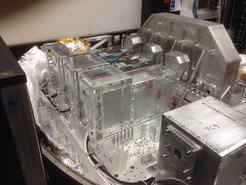MERAC Prize for Oliver Pfuhl
Oliver Pfuhl started his PhD in 2008 on the GRAVITY project and contributed to the overall design of this new VLTI instrument. The VLTI is the only array of 8m-class telescopes that explicitly included interferometry in its design and implementation: with its four 8m telescopes and a total collecting area of 200 m2, it allows direct imaging at high sensitivity and high image quality. GRAVITY will for the first time utilize this unique capability, providing simultaneous interferometry of two objects. This allows narrow angle astrometry with a precision on the order of ten microarcseconds. A second new and unique element of GRAVITY is the use of infrared wavefront sensors to observe highly extincted objects.

The key components for enabling waveguide based stellar interferometry, the fibre coupler and the guiding system, was developed by Oliver Pfuhl. The fibre coupler he designed is unique for its compactness, elegance, and innovative use of modern technology. The unit offers all the functions necessary for precision control of the optical path, including tip/tilt-, pupil-, and piston control, field de-rotation, and polarisation control. He also made an innovative design for the guiding system, which actively corrects for tilt and pupil errors resulting from numerous reflections over the optical path – 100 metres – between the telescopes and the instrument.
The astrophysical part of Oliver Pfuhlʼs thesis is a spectroscopic study of more than 500 stars in the nuclear star cluster at the Galactic centre, which shows that this cluster formed most of its stars more than 5 billion years ago. The PhD thesis of Oliver Pfuhl was carried out under the Supervision of Prof. Reinhard Genzel and Dr. Frank Eisenhauer at the MPE. After his PhD in July 2012, Oliver Pfuhl took a postdoctoral position at MPE. He is currently seconded to ESO Chile for one year to ensure that GRAVITY is successfully commissioned at the VLTI.
The FONDATION MERAC (Mobilising European Research in Astrophysics and Cosmology) is a non-profit foundation started in 2012 with headquarters in Switzerland to recognise and support young European astronomers. There are yearly three MERAC Prizes awarded by the European Astronomical Society. The prizes of 20'000 € are for each of the three categories: Theoretical Astrophysics, Observational Astrophysics, and New Technologies (Instrumental/Computational). The prizes alternate by year for either “Best Early Career Researcher” or “Best Doctoral Thesis”.












